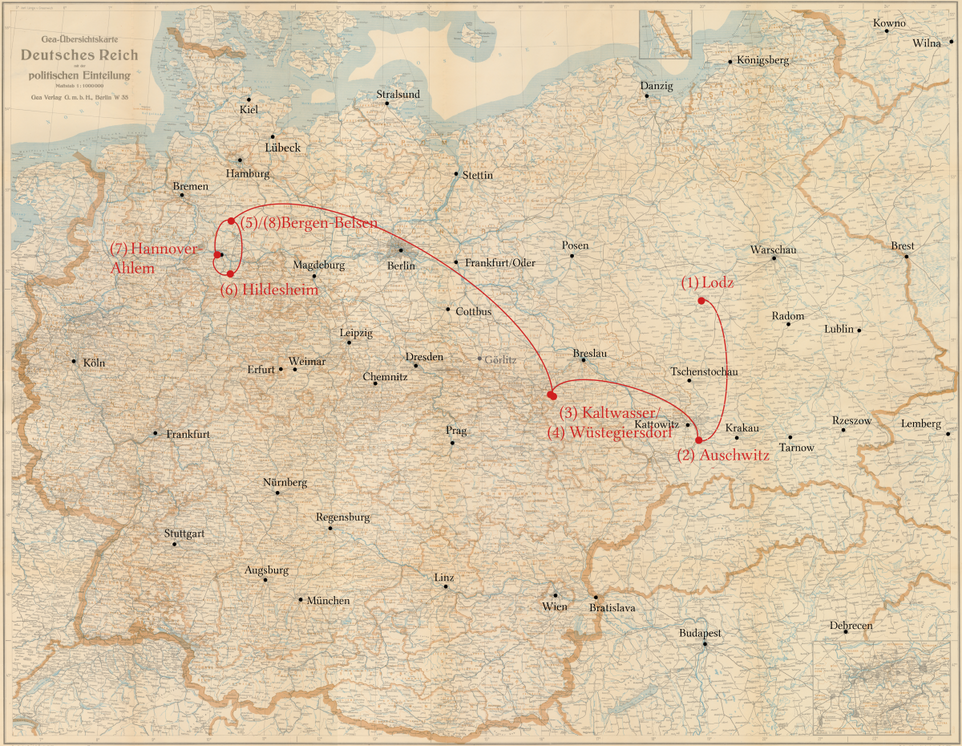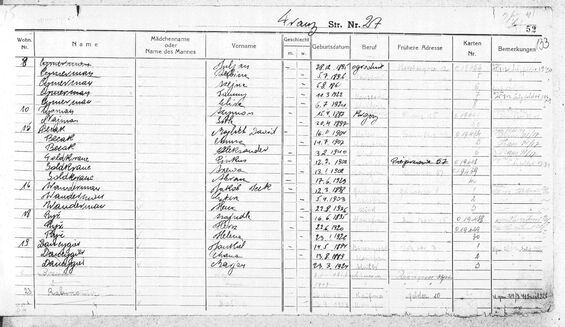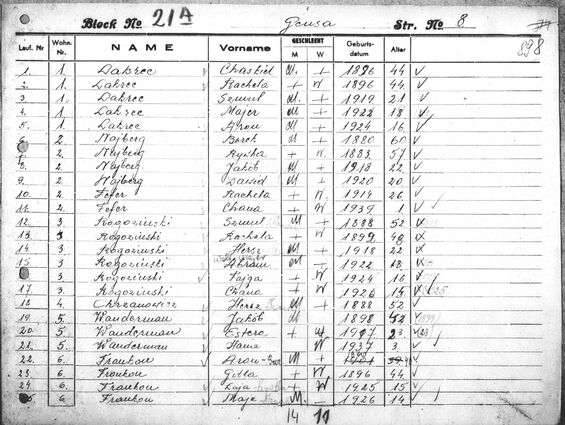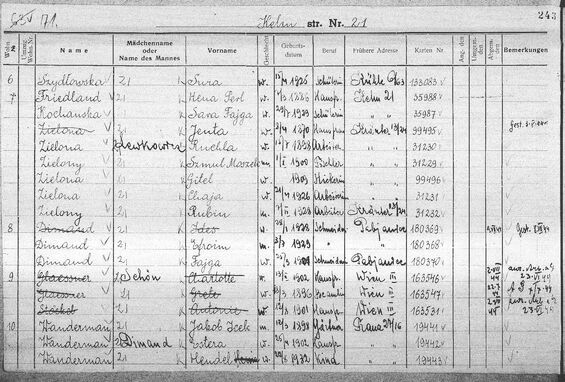The Biography of Jakob Wandermann, Lodz
Short biography and stations of his persecution
- born 10.3.1898 in Uniejow
- trained as a gardener
- 1920-1924 military service
- Self-employed gardener with 20 to 40 employees, depending on the season
- 1930 Marriage to wife Estera Wanderman, born 5.4.1902 in Pabianice, née Dimant
- 22.8.1936 Birth of daughter Hena
- 1939 Expropriation, "resettlement" to Lodz
- 1 May 1940 to August 1944 Lodz ghetto, forced labour in agriculture
- August 1944 Auschwitz concentration camp, transit camp
- September 1944 to October 1944 Groß-Rosen/Kaltwasser concentration camp (Project Riese)
- October 1944 to February 1945 Groß Rosen/Wüstegiersdorf concentration camp (Project Riese)
- February 1945 to early April 1945 Neuengamme/Hildesheim concentration camp
- Neuengamme/Hannover-Ahlem concentration camp
- 10.4.1945 - 15.4.1945 Bergen-Belsen concentration camp
- 1945-1949 DP Camps Hamburg
- 1949 Emigration to Israel
Lost wife, daughter, parents and five siblings. Wife Estera Wanderman, born 5.4.1902/3 in Pabianice, née Dimant and child Hena?, born 22.8.1936 in Lodz (United States Holocaust Memorial Museum)
Before the persecution
After attending 7th grade compulsory school, 3-year apprenticeship as a gardener. Was then self-employed as a gardener in his own nursery. Military service in the Polish army from 1920 to 1924. First marriage in 1930.
Source: Expert opinion 1964, file Jakob Wandermann, Staatsarchiv Hamburg, Signature 351-11_20641
Begin of Persecution, Ghetto
I arrived in the Lodz ghetto at the beginning of 1940, which was an open ghetto until April 1940. Then it was closed. The commandant was BIEBOW, the Jewish elder was called RUMKOWSKI. I worked there in the economic and agricultural department as a gardener. The head of this department was called SCHWINDT.
Source: affidavit from 1954, Hamburg State Archives, Jakob Wanderman file, shelfmark 351-11_20641
1939 Expropriation. Early 1940 transfer to the Lodz ghetto, where he was forced to work as a gardener for the Wehrmacht until the ghetto was liquidated in August 1944. [....] During his stay in the ghetto, applicant was also severely abused by the Gestapo and suffered from the consequences of these atrocities for a long time.
Source: Expert opinion 1964, file Jakob Wandermann, Staatsarchiv Hamburg, Signature 351-11_20641
According to the occupancy plans, the Wandermann family lived in the following houses in the Lodz ghetto: Gänsa 8/room 5, Franzstrasse 27/room 16, Kelmstrasse 21/room 10
Concentration Camps
I was sent to Auschwitz in August 1944, lived in the gypsy camp and after another 2 weeks I was sent to Kaltwasser. After a month, in October 1944, I was taken to Wüstegiersdorf, where I worked in the craft workshop. In February 1945 we were evacuated to Bergen-Belsen, partly on foot, partly by train, without any food, and once there we were sent on to Hildesheim after 1 day. I worked on the railway there. We were transported to the concentration camp Allen (note: Hannover-Ahlem) at the beginning of April 1945. where I was employed in the quarry on the night shift. Around 10 April 1945 we were taken back to Bergen-Belsen, where I was liberated by the 2nd British Army on 15 April 1945.
Source: affidavit from 1954
Claimant lived in the ghetto until autumn 1944, together with his wife and child, and when the ghetto was liquidated, they were transferred to Auschwitz, where applicant's wife died in the gas chamber.
Applicant only stayed in Auschwitz for a short time and was then transferred to KL Kaltwasser in Central Silesia. There he had to do various hard physical labour with a minimum of food, was mistreated and lived in fear. After a few months, he was taken on a foot march to Bergen-Belsen concentration camp, from where he was sent to Hildesheim for two months to clear up bomb damage. He later returned to Bergen-Belsen, where he was liberated by the British in April 1945.
Source: Expert opinion 1964, file Jakob Wandermann, Staatsarchiv Hamburg, Signature 351-11_20641
He was then sent to the Auschwitz-Kaltwasser concentration camp, where he worked at the railway station loading and unloading building materials. According to his own statements, he then worked at the Allen (note: Neuengamme/annover-Ahlem) concentration camp in the quarry and finally at the Bergen-Belsen concentration camp in the death squad. In Auschwitz, he lost his wife and their child. From Bergen-Belsen concentration camp, he also worked for 2 months in Hildesheim with a clean-up squad
Source: Expert opinion 1964, file Jakob Wandermann, Staatsarchiv Hamburg, Signature 351-11_20641
Notes
ECG: THE UNITED STATES HOLOCAUST MEMORIAL MUSEUM, Encyclopedia of CAMPS AND GHETTOS, 1933–1945
KZ Neuengamme/Hildesheim
The establishment of a subcamp in Hildesheim was a reaction to the massive destruction during a bombing raid on February 22, 1945, of the goods railway yard and the main railway line from Hildesheim to Dresden via Leipzig. Labor was needed to repair the destruction. .... 3 days after the attack on March 22, 1945, the camp was evacuated to Hannover-Ahlem.
The surviving prisoners then commenced a march lasting several days to Hannover to the Ahlem subcamp. They were evacuated from there on April 6, with the Ahlem prisoners, to Bergen-Belsen.
Quelle: ECG, Vol 1, Part B, p. 1147 f
KZ Neuengamme/Hannover-Ahlem
„The camp was created to supply prisoners for labor to the nearby asphalt tunnels, which were to be cleared to accommodate the underground, accelerated construction of aircraft and panzer parts for Continental Gummiwerke and Maschinenfabrik Niedersachsen Hannover (MNH).
… Kapos beat the prisoners into submission with shovels. Their beatings sometimes resulted in death.
Quelle: ECG, Vol 1, Part B, p. 1133
KZ Groß Rosen/Kaltwasser (Projekt Riese)
Concentration camp Groß Rosen/Kaltwasser (Project Riese)
Location: between Wüstegiersdorf and Kaltwasser
Opening: -
Number of prisoners: no more than 2000
Prisoner transports: end of August 1944 from Auschwitz, 20 September 1944 from Auschwitz
Work: The prisoners' main workplace was the projects under construction on Ramenberg (later Soboń) Mountain: they levelled and surfaced the ground for a narrow-gauge railway track; they carried the rails; set down new tracks; felled trees to build new roads; dug ditches and put in sewers; cleared forests; unloaded railroad cars loaded with concrete, sand, and bricks; dumped stones out of trucks and shoveled them into ravines; and installed poles for electric wires. Some of the prisoners worked making cobblestones for road paving: rocks were dynamited, and the larger pieces were broken up into smaller ones and worked down to the required size. The prisoners worked in two shifts regardless of the weather. All the labour was very hard and dangerous, and there were frequent accidents. There were also instances of suicide.
Companies:
Closing: December 1944
Source: ECG, Vol. 1, Part A, p. 790 f
Concentration camp Groß Rosen/Wüstegiersdorf (Project Riese)
Location: Wüstegiersdorf
Opening: May 1944
Number of prisoners: 700 - 1000 Hungarian and Polish Jews
Prisoner transports:
Work: see below
Companies: Messinger, Tiefbau, Sager & Wörner, Wayss & Freytag, Hoch und Tiefbau, Fix (built barracks), Dübner (tunnel construction), Websky (machinery dismantling), Holzmann, Schallhorn, Lenz, Krup, and National Socialist Motor Corps (National-sozialistisches Kraftfahrkorps, NSKK).
Closing: 24 February 1945 on foot to Trautenau, by train to Flossenbürg
Source: ECG, Vol. 1, Part A, p. 798
After the War
About 10 April 1945 we were taken back to Bergen-Belsen, and there I was liberated by the 2nd British Army on 15 April 1945. In autumn 1945 I came to Hamburg, where I was employed as a gardener in the children's home. In autumn 1947 I returned to Bergen-Belsen, from where I emigrated to Israel on 5 April 1949.
Source: affidavit
Applicant did not return to Poland, he lived in a children's home in Hamburg, where he also worked as a gardener. He then spent some time in the Bergen-Belsen DP camp and emigrated to Israel in 1949. He married for the second time in 1947.
Source: Expert opinion
Notes
Compensation Offiice
Hamburg
Additonal Sources
Block Number 21A Gänsa Street Number 8/The elders of the Jews in the Lodz Ghetto
Kelm Street Number 21/The elders of the Jews in the Lodz Ghetto
Franz Street Number 27/The elders of the Jews in the Lodz Ghetto
File Jakob Wandermann, Staatsarchiv Hamburg, Signature 351-11_20641
Notes
Why there may be different (birth) dates:
Enquiry from the Hamburg Office for Restitution dated 20 March 1964 to Kittl
"On reviewing the file, it is noticeable that your client has always given 14 April 1908 as his date of birth, whereas he now gives 10 March 1898 as his date of birth. You are requested to state why your client has previously given an incorrect date of birth."
Reply dated 25 April 1964 from Wandermann
"In order to be accepted into the kibbutz (joint agricultural preparation) in Blankenese near Hamburg with which I was to immigrate to Israel, I made myself 10 years younger - as older people were not accepted - i.e. I gave the date of birth 14 April 1908 In reality, I was born on 10 March 1898, as can also be seen from the extract from my identity card."
Photo Credits
see above



